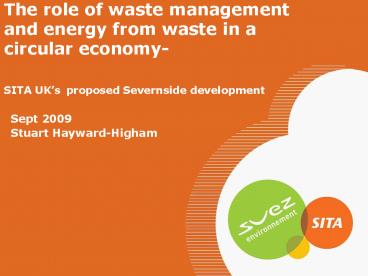The role of waste management and energy from waste in a circular economy SITA UKs proposed Severnsid - PowerPoint PPT Presentation
1 / 23
Title:
The role of waste management and energy from waste in a circular economy SITA UKs proposed Severnsid
Description:
Aluminium. 5 tonnes of bauxite. 5 12 tonnes of CO2 equivalents ... Aluminium. Plastics and Iron. Energy saved when products. are made from recycled materials ... – PowerPoint PPT presentation
Number of Views:296
Avg rating:3.0/5.0
Title: The role of waste management and energy from waste in a circular economy SITA UKs proposed Severnsid
1
The role of waste management and energy from
waste in a circular economy- SITA UKs proposed
Severnside development
- Sept 2009
- Stuart Hayward-Higham
2
SITA UK
- SITA UK is a recycling and resource management
company - We serve over 12 million customers, and
- Over 30,000 businesses.
- Handle nearly 11 million tonnes of material
- Of which in excess of 3 million tonnes are
recycled - Over 1 million tonnes is used for energy
production - We produce in excess of 1 million MWhrs of
electricity - Produce around 3 of all the green electricity in
the UK - Employ over 6000 employees across the country
3
SITA UKs vision
- We want to live
- in a society where there
- is no more waste
- In the future there will be no more waste as
materials will be viewed as products or raw
materials
4
What is waste management ?
Large / small
Large / small
Large / small
TRADING
SEPARATION
5
A plethora of potential solutions
6
What is a circular economy
7
Solution preferences
8
Why change the existing solutions ?
- Capacity
- Existing landfill capacity is reducing and
replacements are insufficient. - Cost
- Landfill tax, transport costs ( as existing
landfill solutions become more scarce ), carbon
etc all raise the cost of existing solutions and
drive waste into the minimisation, recycling and
recovery solutions - Sustainability
- There are better ways of treating most waste than
by landfill, however the replacement capacity is
needed in a time period and scale to ensure that
those who need waste management services are
viably service options.
9
Prevention, minimisation re-use
- Prevention
- best of all and completely customer driven and
controlled - Minimisation
- Through education, buying patterns and efficient
use. Very customer driven but advice available. - Re-Use
- Encouraged through bring back or re sale again
customer driven but advice and end markets are
available.
10
Role of recycling
11
Recycling
- Collection
- Separate at source is best, separate later is
possible. - Sorting
- From simple magnets and consolidation though to
complex sorting, separation and refinement - End market
- Sent to reprocessors to be made into new cans,
bottles etc
12
Recyclings contribution to sustainability
Paper
100
Aluminium
80
Plastics and Iron
60
Energy saved when products are made from
recycled materials
40
Glass
20
0
13
But
- Not all waste can be avoided or recycled which
leaves us with extracting energy or landfill. - Our preference is to extract the energy.
- To produce electricity, gas or heat and use it in
the most efficient manner. - Location of plants is essential to marry with the
markets or waste arising and potential energy and
heat users. - We recover some of the energy from the organic
landfill wastes but not as efficiently nor as
completely than by energy from waste.
14
Energy from Waste ?
- Why make energy ?
- With the potential national supply issues over
the next 20 years and instability in
international markets, the recovery of energy
from waste has the opportunity to make a
significant contribution to national need. - Recovering energy from waste is a sustainable
solution for the treatment of the residual
fraction of the waste left over after
recycling/composting/pre-treatment.
From Oakdene Hollins report 2005
15
Energy from Waste methods
- Combustion to create steam and then electricity.
- Gasification/pyrolysis (Gasification is proposed
by the Cyclamax development) which converts the
waste to a gas and then combusts the gas to make
electricity. - Anaerobic digestion biological conversion of
the organic fraction of waste to a methane gas
and then combustion to make electricity or the
gas (after clean up) for vehicle fuel .
16
What does an EfW (incinerator) look like inside?
17
Inside Moving grate combustion zone
18
Outside look
Small
Large
19
Severnside Proposal
- 400ktpa facility
- From a market in excess of 1.1M tonnes per annum
(tpa) - Energy
- Sufficient for around 50,000 homes
- 32 MW of electrical output
- Location
- Good location for treating local waste
- Delivery possible through road and rail
- Near potential users of the heat from the plant
- Community
- 200 jobs through the construction phase
- 50 jobs in the plant
20
Site location
21
Location efficiency Local embedment
- Transport good road and rail access
- Local waste helping divert some local waste
from landfill to more productive use - Local energy using local fuel ( i.e. local
waste) to make energy locally - Local benefit managing local waste with local
facilities and employment
22
What role does EFW have in a circular economy ?
An essential one because not all waste can be
re-used or recycled Its an essential way of
recovering the remaining embedded benefits of
residual waste
23
Thank you
- Stuart Hayward-Higham
- Technical Director
- SITA UK Ltd
- Stuart.hayward-higham_at_sita.co.uk
- 44 7970 233747































